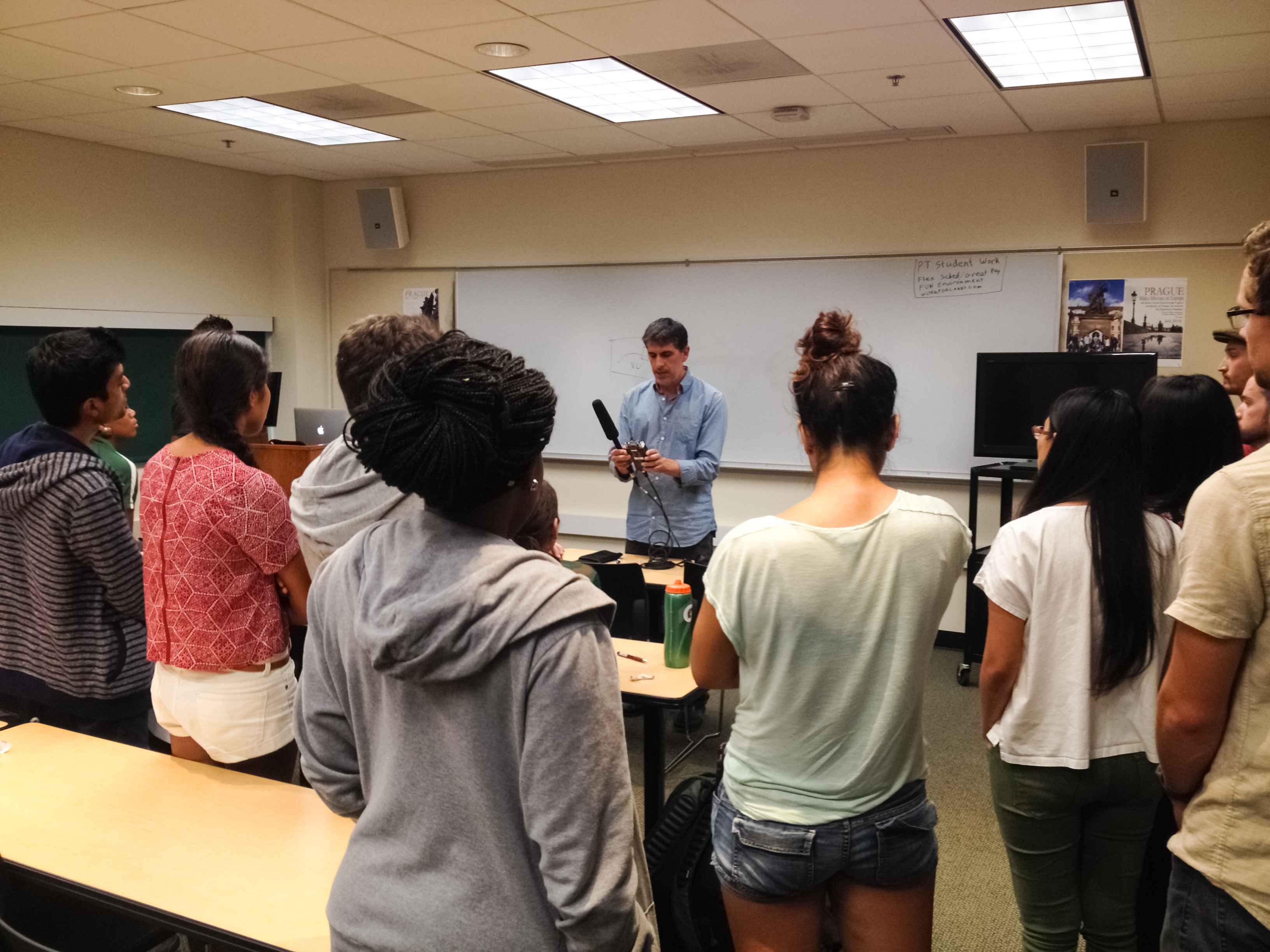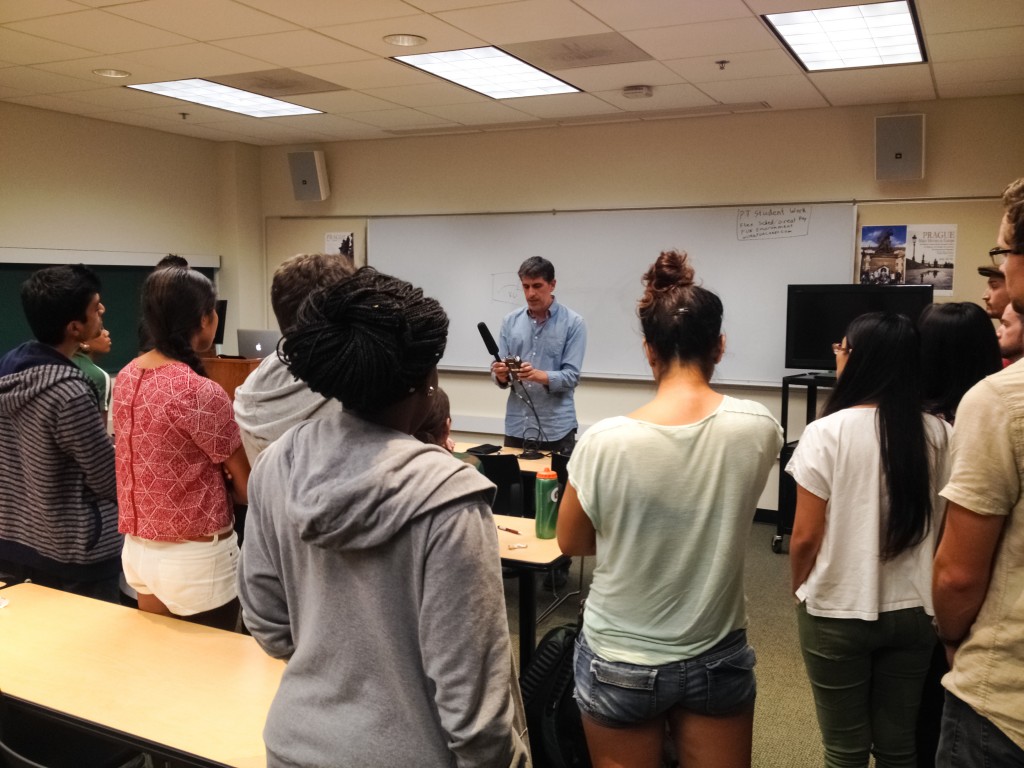

“Community Science: Autism” class how to properly use a microphone. Sherman Hewitt // Online Editor
The Class
The Community Science: Autism class brings students from journalistic and biological backgrounds together. Every Wednesday, the two groups aim to understand the complex world behind Autism Spectrum Disorder (ASD).
The three-hour course exposes students to both the historical and the academic aspects of ASD, showing how societal perceptions and research have evolved. Guest speakers, all of whom work on cutting-edge research, visited to share details of their line of study. From genetics to brain imaging to early-detection methods, the speakers depicted many different angles of ASD research.
Throughout the semester, teams of biology and communication students will produce mini-documentaries featuring members of the autism community. These video projects allow students to better connect the class’ concepts with the individuals who live them.
“Any time you go out and connect with people – see how they live, what they’re going through – that’s a real education,” said Jim Virga, communications professor and co-teacher of the course. “When you teach a class that is a content-gathering class, you’re really starting a relationship. So, with all these kids and what they learn this semester, it’s more about what they’re going to do with it down the road.”
Biology professor Julia Dallman, who teaches the class with Virga, sees the class as a chance for students to make their college education more meaningful.
“What are you doing at a university? You’re trying to decide what to do with your life,” she said. “You want that thing you do to be meaningful, so this is an opportunity to teach the biology in a context that’s totally meaningful to the community.”
The class originated after a chance meeting between Dallman and Virga. To promote the University of Miami, Virga was assigned to shoot video of Dallman and her zebrafish research lab. The process helped Dallman and Virga realize how video can effectively convey technical scientific information.
“Because science can be a little bit siloed because of our technical language, I thought it’d be fun to teach a course where the scientists work with the communications experts,” Dallman said. “In some ways, [science] experts are crippled by their specialized vocabulary, so by having science and communication students learn the lingo together, [the class] has the potential to teach both why the science is interesting and how to communicate it.”
With her expertise in autism research, Dallman teaches the biological concepts while Virga, with his background as a photojournalist and filmmaker, teaches the craft behind compelling, focused stories.
Biology major David Farag loves the class, especially the guest speakers’ diverse topics.
“The guest speakers are really knowledgeable in their areas and hitting on different points, so it’s not boring,” he said. “It’s new information from every speaker, so it’s not all the same, repetitive, ‘Oh, this is what autism does.’ That is super cool.”
A diverse set of speakers combined with the documentary aspect provides a chance to better understand autism’s impact, according to Kara McCormack, a graduate student who studies math.
“I hope to gain a better understanding of autism and how it affects our society,” she said. “Not only that, but I want to learn about the lives of specific individuals with ASD and what they do on a daily basis to aid in their social skills.”
For the documentary, McCormack’s team reached out to a boy named Sebastian who is seven years old and has high-functioning ASD. In meeting with Sebastian and his mother, the team learned about his interest in science, what he likes to do in his free time and his hope to be an astrophysicist one day.
“He just thinks it is all very fascinating,” McCormack said. “In his free time, he loves to play computer games and video games.”
Her team also met with Dr. Daniel Messinger, a University of Miami psychology professor who investigates the social and emotional development of infants and children. In particular, he studies the younger brothers and sisters of kids with an ASD as a way to understand the development of autism.
“Autism provides a case in which social interaction goes awry,” he said.
Messinger was a guest speaker for the class and had a great experience talking to the students and McCormack’s team.
“They were super engaged and they asked great questions. A group of them interviewed me and it was a lot of fun,” Messinger said.
Through the documentary project, Virga hopes his students can become better members of society.
”By being sensitive to other people, I think we become better members of the community,” he said. “It becomes a better community when we see the circumstances other people are in.”
What is Autism Spectrum Disorder?
According to the American Psychiatric Association, “autism” generally refers to two symptoms: limited social and communication skills and repetitive, restrictive or stereotyped patterns of behavior. The term “Autism Spectrum Disorder” refers to a range of different disorders, such as Asperger’s Syndrome, Autistic Disorder and Rett’s Syndrome.
Referring to autism as a spectrum shows how one person with an ASD can have more mild symptoms than another person with an ASD. A person diagnosed with Asperger’s may be incredibly bright and independent but still have limited social skills; another person may need constant support to make it through the day.
According to a 2014 Center for Disease Control and Prevention report, one in 68 children have an ASD. This statistic is up from a report of one in 150 children in 2000.
The same report shows that ASD in boys (one in 42) is almost five times more common than ASD in girls (one in 189).
Though a single cause is unknown, early diagnosis of and care for people with an ASD can lead to substantial progress, according to the UM Center for Autism and Related Disabilities’ (CARD) website. Diagnoses can happen as early as age two.
“We’re there with the family when they get a diagnosis and every transition point throughout that child’s life,” said Dr. Michael Alessandri, executive director of CARD and another guest speaker.
In his talk with the class, Alessandri shared the moment that sparked his more than 30-year effort to help people with an ASD.
“It was like my own personal journey into autism,” he said. “For me, it started as a student who graduated from high school and showed up to volunteer at a summer camp for kids with disabilities. On the first day, I met a boy – Marlin, a little black kid from New York – and I was assigned to him for that one day, and fell in love with autism. Marlin was amazing. I’ve been doing autism since. That was 1981 … It changed my life, that one experience.”
Center for Autism and Related Disabilities
A collaboration between UM and Nova Southeastern University, the center works to help people with disabilities.
According to Alessandri, governments and schools have gaps in their ASD services. Schools do help kids with ASD, but once kids leave the school’s area of influence, services halt and kids have to somehow traverse that gap to their next place of care. CARD works to fill that gap.
“We try to be the glue that pulls all the pieces together,” Alessandri said. “We have to help families and clients make those connections.”
CARD’s services include individualized support for families and clients, family and professional training, community outreach, public education, and awareness. If any of CARD’s 9,000 families require additional aid, these services are available for as long as necessary.
“I do think that we’re the thread that goes through all those critical periods in life,” he said. “We’re not ever done with them. We’ll be there for as long as they need us.”
The Autism Identification Cards service, launched in September 2014, has done well so far, according to Alessandri. The cards allow people with ASD to inform police officers or first responders of their condition. This knowledge can help officers handle potentially tense situations, like an individual who may be acting suspiciously, but only has an ASD. The center has received requests for cards from all over the world, even as far as Australia. Due to the ID cards being a newer initiative, CARD is still watching for results.
“I want to count on our law enforcement, but they need the right tools and information to make the right judgments,” Alessandri said.
Video: http://www.justdigit.org/wallet-cards/
Though people with an ASD may need some extra help, Alessandri believes that ASD shouldn’t be a person’s defining feature. Autism may even be a feature shared by everyone.
“We’re all different things. I actually think we all have a little bit of autism in us, and that’s not a bad thing,” he said. “I hope that we’re all laser-focused when we need to be, or a little cautious with how we approach and interact with people. I hope that we’re intense in some situations and talented in others. I hope for that.”





